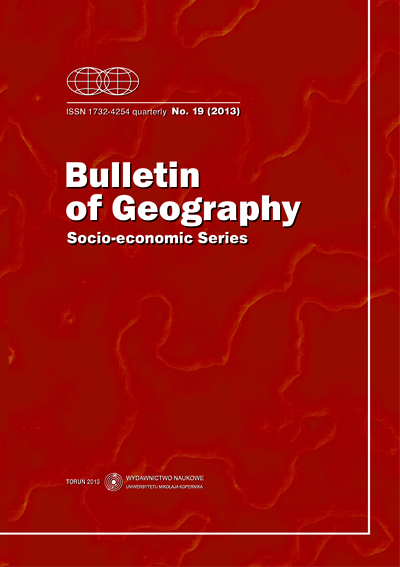The Community Initiative LEADER I and the implementation and results of the Hungarian Pilot LEADER programme in rural development
DOI:
https://doi.org/10.1515/bog-2013-0006Keywords
Hungary, rural development, regional planning, LEADERAbstract
The aim of this study is to present the basic methodological elements of the LEADER Community Initiative in rural development established in 1991 and its practical implementation in geography. The most important principle of the LEADER programme is the territorial approach and the appearance of local communities in a relevant subregional and landscape context. The determination and creation of a natural and cultural geographical framework is not at all an easy task, although the LEADER cautiously puts down basic principles and makes clear references to spatial definition of local action groups. The aim of LEADER I is to demonstrate the spatial segregation of these communities and to evolve a particular image and a kind of critical mass (population, resources) to build a relative self-sufficiency.References
Bogumil, J. and Jann, W., 2005: Verwaltung und Verwaltungswissenschaft in Deutschland – (Public administration and science of public administration in Germany – in German). In: Introduction to the Science of Public Administration, Wiesbaden: Springer VS-Publisher for Social Sciences, pp. 65‒132.
Dubost, M., 2008: Gestaltung von Territorien (Forming of regions – in German). In: Leader+ Magazine, 2008/3, pp. 6‒22.
European Commission, 1997: Ex-Post Evaluation of the LEADER I Community Initiative 1989‒1993, 1999, pp. 3‒55.
European Spatial Planning Observation Network, 2003: The territorial impact of CAP and rural development policy, Third Interim Report August 2003, p. 190.
Fazekas, ZS., and Nemes, G., 2005: Kísérleti LEADER-jellegű program Magyarországon. Promei Faluműhely Alapítvány (Experimental LEADER Programme in Hungary – in Hungarian), AVOP LEADER+ készségek elsajátítása, Promei Foundation, pp. 342‒369.
Geiddendörfer, M., 2005: Evaluation von Programmen und Konzepten der ländlichen Strukturentwicklung dargestellt am Beispiel der EU-Gemeinschaftsinitiative LEADER (Evaluation of programs and concepts in the development of rural structures in the case of LEADER programme – in German), PhD Thesis, pp. 5‒68.
Horváth, G., 2002: Regional policy and development in East-Central Europe. In: Domański, R. editor, Cities and Regions in an Enlarging European Union, Warszawa: Polish Academy of Sciences, Committee for Space Economy and Regional Planning, pp. 107‒127.
Hutter, A. and Neidhardt, R., 2005: Stadt-Land: Ein Verhältnis im Wandel, Entwicklung & Ländlicher Raum (City and countryside: development of mutual relation – in German), 2005/5, DLG-Publisher, pp. 13‒15.
Kozma, G., 2003: Az Európai Unió regionális politikája (The Regional Policy of the EU – in Hungarian). In: Szerk Süli-Zakar I., a terület- és településfejlesztés alapjai, Szeged: Campus Dialog, pp.181‒205.
Leader Koordinierungstelle/AEIDL, 1994: Verzeichnis der deutschen lokalen Aktionsgruppen (Registry of the local action groups in Germany – in German), p. 32.
Madarász, I., 2000: Hogyan készítsünk vidékfejlesztési programot? (How to create rural development programs? – in Hungarian), p. 194.
Ray, C., 1998: Territories, Structures and Interpretation – Two case studies of the European Union’s LEADER I Programme. In: Journal of Rural Studies, Vol. 14, No.1, pp.79‒87.
Ruszkai, CS., 2006: The co-operation of rural areas in the LEADER+ Programme. In: Süli-Zakar, I. and Horga, I. editors, Regional Development in the Romanian-Hungarian Cross-border Space – from National to European Perspective, Debrecen: Kossuth Egyetemi Kiadó, pp. 393‒396.
Ruszkai, CS., 2009: A területiség vizsgálata a LEADER fejlesztési módszertan keretén belül (Building up regional structures in the LEADER Programme – in Hungarian). In: Acta Iuventutis Geographica, Institutium Socio-Geographie Universitatis Debreceniensis, Szerk: Süli‑Zakar I, pp. 159‒166.
Shucksmith, M., 2000: Endogenous development, social capital and social inclusion: perspectives from LEADER in the UK. In: Sociologia Ruralis, 40, Issue 2, pp. 208–218.
Stöhr, L. and Schenk, W., 1997: Die Umsetzung des EU-Förderprogramms LEADER (Implementing the European LEADER Programme – in German). In: Raumforschung und Raumordnung, 6, pp. 421‒431.
http://ec.europa.eu/agriculture/rur/leader1/ (DoA: 2010.03.26)
http://lexikon.freenet.de/Kreisfreie_Stadt (DoA: 2011.01.02).
http://www.adata.hu/_Kozossegi_Adattar/parolaar.nsf/0/39e3b00209fa1072c1256ec500283e86?OpenDocument (DoA: 2010.10.10).
http://www.arfolyamkereso.com/? currency=EUR&all=1&start_date=2009‒11-11&end_date=2010‒01‒10#graph (DoA: 2011.01.03).
http://www.fvm.gov.hu/main.php? folderID=908&articleID=3859&ctag=articlelist&iid=1 (DoA: 2010.10.10)
Downloads
Published
How to Cite
Issue
Section
License
Title, logo and layout of journal Bulletin of Geography. Socio-economic Series are reserved trademarks of Bulletin of Geography. Socio-economic Series.Stats
Number of views and downloads: 0
Number of citations: 0



